The Influence of Bacteria-Inoculated Mineral Fertilizer on the Productivity and Profitability of Spring Barley Cultivation
Abstract
1. Introduction
2. Results and Discussion
2.1. Spring Barley Productivity Indicators
2.2. Results of Economic Evaluation
3. Materials and Methods
3.1. Site Description
3.2. Experimental Design and Agronomic Practice
3.3. Plant Sampling
3.4. Determination of Plant Yield and Biometric Parameters
3.5. Methodology of Economic Evaluation
3.6. Meteorological Conditions
3.7. Statistical Analysis
4. Conclusions
Supplementary Materials
Author Contributions
Funding
Data Availability Statement
Conflicts of Interest
References and Notes
- Kominko, H.; Gorazda, K.; Wzorek, Z. Formulation and evaluation of organo-mineral fertilizers based on sewage sludge optimized for maize and sunflower crops. Waste Manag. 2021, 136, 57–66. [Google Scholar] [CrossRef]
- Jovarauskas, D.; Steponavičius, D.; Kemzūraitė, A.; Zinkevičius, R.; Venslauskas, K. Comparative analysis of the environmental impact of conventional and precision spring wheat fertilization under various meteorological conditions. J. Environ. Manag. 2021, 296, 113150. [Google Scholar] [CrossRef]
- Kobierski, M.; Lemanowicz, J.; Wojewódzki, P.; Kondratowicz-Maciejewska, K. The Effect of Organic and Conventional Farming Systems with Different Tillage on Soil Properties and Enzymatic Activity. Agronomy 2020, 10, 1809. [Google Scholar] [CrossRef]
- Kazlauskas, M.; Šarauskis, E.; Lekavičienė, K.; Naujokienė, N.; Romaneckas, K.; Bručienė, I.; Buragienė, S.; Steponavičius, D. The Comparison Analysis of Uniform-and Variable-Rate Fertilizations on Winter Wheat Yield Parameters Using Site-Specific Seeding. Processes 2022, 10, 2717. [Google Scholar] [CrossRef]
- Steponavičius, D.; Raila, A.; Steponavičienė, A.; Lugauskas, A.; Kemzūraitė, A. Preventive measures reducing superficial mycobiotic contamination of grain. Ann. Agric. Environ. Med. 2012, 19, 193–201. [Google Scholar] [PubMed]
- Aguilera, E.; Guzmán, G.; Alonso, A. Greenhouse gas emissions from conventional and organic cropping systems in Spain. I. Herbaceous crops. Agron. Sustain. Dev. 2015, 35, 713–724. [Google Scholar] [CrossRef]
- Rutkovienė, V.; Česonienė, L.; Steponavičius, D. Nitrogen losses from organic and mineral fertilizers in model soil system. Cereal Res. Commun. 2007, 35, 313–316. [Google Scholar] [CrossRef]
- Rokhzadi, A.; Asgharzadeh, A.; Darvish, F.; Nour-Mohammadi, G.; Majidi, E. Influence of plant growth-promoting rhizobacteria on dry matter accumulation and yield of chickpea (Cicer arietinum L.) under field conditions. Am.-Eurasian J. Agric. Environ. Sci. 2008, 3, 253–257. [Google Scholar]
- Malusa, E.; Vassilev, N. A contribution to set a legal framework for biofertilisers. Appl. Microbiol. Biotechnol. 2014, 98, 6599–6607. [Google Scholar] [CrossRef]
- Yadav, K.K.; Sarkar, S. Biofertilizers, impact on soil fertility and crop productivity under sustainable agriculture. Environ. Ecol. 2019, 37, 89–93. [Google Scholar]
- Gavelienė, V.; Šocik, B.; Jankovska-Bortkevič, E.; Jurkonienė, S. Plant Microbial Biostimulants as a Promising Tool to Enhance the Productivity and Quality of Carrot Root Crops. Microorganisms 2021, 9, 1850. [Google Scholar] [CrossRef]
- Biswas, S.S.; Biswas, D.R.; Ghosh, A.; Sarkar, A.; Das, A.; Roy, T. Phosphate solubilizing bacteria inoculated low-grade rock phosphate can supplement P fertilizer to grow wheat in sub-tropical inceptisol. Rhizosphere 2022, 23, 100556. [Google Scholar] [CrossRef]
- Zörb, C.; Senbayram, M.; Peiter, E. Potassium in agriculture–status and perspectives. J. Plant Physiol. 2014, 171, 656–669. [Google Scholar] [CrossRef]
- Meena, V.S.; Maurya, B.R.; Verma, J.P. Does a rhizospheric microorganism enhance K+ availability in agricultural soils? Microbiol. Res. 2014, 169, 337–347. [Google Scholar] [CrossRef]
- Di Salvo, L.P.; Cellucci, G.C.; Carlino, M.E.; de Salamone, I.E.G. Plant growth-promoting rhizobacteria inoculation and nitrogen fertilization increase maize (Zea mays L.) grain yield and modified rhizosphere microbial communities. Appl. Soil Ecol. 2018, 126, 113–120. [Google Scholar] [CrossRef]
- Rana, A.; Saharan, B.; Nain, L.; Prasanna, R.; Shivay, Y.S. Enhancing micronutrient uptake and yield of wheat through bacterial PGPR consortia. Soil Sci. Plant Nutr. 2012, 58, 573–582. [Google Scholar] [CrossRef]
- Zhong, C.J.; Sun, D.S.; Bao, H.; Chen, H. Comparative characteristics and desilicon ability of 10 strains of silicate bacteria screened from different bauxite ores. Adv. Mater. Res. 2012, 524, 953–956. [Google Scholar] [CrossRef]
- Han, H.S.; Lee, K.D. Effect of co-inoculation with phosphate and potassium solubilizing bacteria on mineral uptake and growth of pepper and cucumber. Plant Soil Environ. 2006, 52, 130. [Google Scholar] [CrossRef]
- Vejan, P.; Khadiran, T.; Abdullah, R. Noraini Ahmad Controlled release fertilizer: A review on developments, applications and potential in agriculture. J. Control. Release 2021, 339, 321–334. [Google Scholar] [CrossRef]
- Li, Y.; Jia, C.; Zhang, X.; Jiang, Y.; Zhang, M.; Lu, P.; Chen, H. Synthesis and performance of bio-based epoxy coated urea as controlled release fertilizer. Prog. Org. Coat. 2018, 119, 50–56. [Google Scholar] [CrossRef]
- Zhang, S.; Yang, Y.; Gao, B.; Li, Y.C.; Liu, Z. Superhydrophobic controlled-release fertilizers coated with bio-based polymers with organosilicon and nano-silica modifications. J. Mater. Chem. A 2017, 5, 19943–19953. [Google Scholar] [CrossRef]
- Khan, M.S.; Zaidi, A.; Wani, P.A. Role of phosphate-solubilizing microorganisms in sustainable agriculture—A review. Agron. Sustain. Dev. 2007, 27, 29–43. [Google Scholar] [CrossRef]
- Kibler, M.K.; Reinhart, D.; Hawkins, C.; Motlagh, A.M.; Wright, J. Food waste and the food-energy-water nexus: A review of food waste management alternatives. Waste Manag. 2018, 74, 56–62. [Google Scholar] [CrossRef]
- Lapeyrie, F. Oxalate synthesis from soil bicarbonate by the mycorrhizal fungus Paxillus involutus. Plant Soil 1988, 110, 3–8. [Google Scholar] [CrossRef]
- Marshner, P.; Crowley, D.E.; Higashi, M. Root exudation and physiological status of a root colonizing fluorescent Pseudomonad in mycorrhizal and non-mycorrhizal pepper (Capsicum annum L.). Plant Soil 1997, 189, 11–20. [Google Scholar] [CrossRef]
- Remy, W.; Taylor, T.N.; Hass, H.; Kerp, H. Four hundred-million-year-old vesicular arbuscular mycorrhizae. Proc. Natl. Acad. Sci. USA 1994, 91, 11841–11843. [Google Scholar] [CrossRef] [PubMed]
- Hobbie, S.E. Effects of plant species on nutrient cycling. Trends Ecol. Evol. 1992, 7, 336–339. [Google Scholar] [CrossRef]
- Conant, R.T.; Walsh, R.P.; Walsh, M.P.; Bell, C.W.; Wallenstein, M.D. Effects of a microbial biostimulant, mammoth PTM, on Cannabis sativa bud yield. J. Hortic. 2017, 4, 191. [Google Scholar] [CrossRef]
- Wang, Y.; Yan, X.; Su, M.; Li, J.; Man, T.; Wang, S.; Li, C.; Gao, S.; Zhang, R.; Zhang, M.; et al. Isolation of potassium solubilizing bacteria in soil and preparation of liquid bacteria fertilizer from food wastewater. Biochem. Eng. J. 2022, 181, 108378. [Google Scholar] [CrossRef]
- Marulanda, A.; Porcel, R.; Barea, J.M.; Azcón, R. Drought tolerance and antioxidant activities in lavender plants colonized by native drought-tolerant or drought-sensitive Glomus species. Microb. Ecol. 2007, 54, 543–552. [Google Scholar] [CrossRef]
- Marschner, H.; Kirkby, E.A.; Cakmak, I. Effect of mineral nutritional status on shoot-root partitioning of photoassimilates and cycling of mineral nutrients. J. Exp. Bot. 1996, 47, 1255–1263. [Google Scholar] [CrossRef]
- Lambers, H.; Martinoia, E.; Renton, M. Plant adaptations to severely phosphorus-impoverished soils. Curr. Opin. Plant Biol. 2015, 25, 23–31. [Google Scholar] [CrossRef] [PubMed]
- Shen, J.; Yuan, L.; Zhang, J.; Li, H.; Bai, Z.; Chen, X.; Zhang, W.; Zhang, F. Phosphorus dynamics: From soil to plant. Plant Physiol. 2011, 156, 997–1005. [Google Scholar] [CrossRef] [PubMed]
- Afkairin, A.; Ippolito, J.A.; Stromberger, M.; Davis, J.G. Solubilization of organic phosphorus sources by cyanobacteria and a commercially available bacterial consortium. Appl. Soil Ecol. 2021, 162, 103900. [Google Scholar] [CrossRef]
- Ahmad, S.; Imran, M.; Hussain, S.; Mahmood, S.; Hussain, A.; Hasnain, M. Bacterial impregnation of mineral fertilizers improves yield and nutrient use efficiency of wheat. Sci. Food Agric. 2017, 97, 3685–3690. [Google Scholar] [CrossRef]
- Xiao, X.; Zhu, Y.; Gao, C.; Zhang, Y.; Gao, Y.; Zhao, Y. Microbial inoculations improved rice yields by altering the presence of soil rare bacteria. Microbiol. Res. 2022, 254, 126910. [Google Scholar] [CrossRef]
- Nautiyal, C.S.; Bhadauria, S.; Kumar, P.; Lal, H.; Mondal, R.; Verma, D. Stress induced phosphate solubilization in bacteria isolated from alkaline soils. FEMS 2000, 182, 291–296. [Google Scholar] [CrossRef]
- Canellas, L.P.; Olivares, F.L. Physiological responses to humic substances as plant growth promoter. Chem. Biol. Technol. Agric. 2014, 1, 3. [Google Scholar] [CrossRef]
- Cordell, D.; White, S. Peak phosphorus: Clarifying the key issues of a vigorous debate about long-term phosphorus security. Sustainability 2011, 3, 2027–2049. [Google Scholar] [CrossRef]
- Cordell, D.; White, S. Life’s bottleneck: Sustaining the world’s phosphorus for a food secure future. Annu. Rev. Environ. Resour. 2014, 39, 161–188. [Google Scholar] [CrossRef]
- Naujokienė, V.; Lekavičienė, K.; Šarauskis, E.; Bendoraitytė, A. Using a Soil Bioregeneration Approach to Reduce Soil Compaction and Financial Costs of Planting Winter Wheat and Rapeseed. Agriculture 2022, 12, 666. [Google Scholar] [CrossRef]
- Romaneckas, K.; Pilipavičius, V.; Trečiokas, K.; Šarauskis, E.; Liakas, V. Agronomy Basics; Aleksandras Stulginskis University: Akademija, Lithuania, 2017; pp. 403–405. [Google Scholar]
- Adamavičienė, A.; Romaneckas, K.; Pilipavičius, V.; Avižienytė, D.; Šarauskis, E.; Sakalauskas, A. Interaction of maize and living mulch: Soil chemical properties and bioactivity. J. Food Agric. Environ. 2012, 10, 1219–1223. [Google Scholar]
- Olsson, U.; Engstrand, U.; Rupšys, P. Statistical Methods Using SAS and MINITAB; Lithuanian University of Agriculture: Akademija, Lithuania, 2000. [Google Scholar]
- Anušauskas, M. Farm financial statements, Alytus, Lithuania, 2020.
- Anušauskas, M. Farm financial statements, Alytus, Lithuania, 2021.
- Anušauskas, M. Farm financial statements, Alytus, Lithuania, 2022.
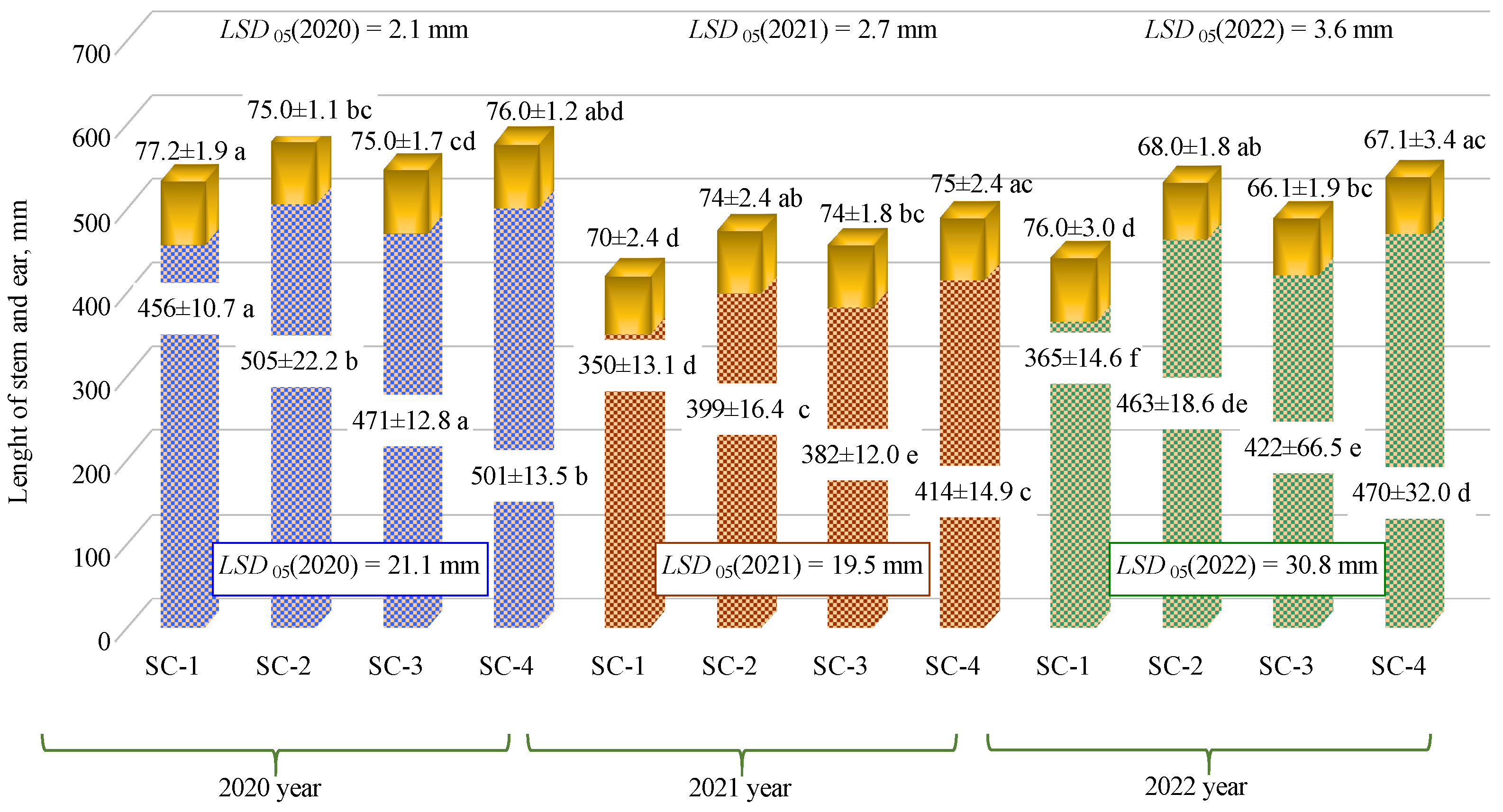
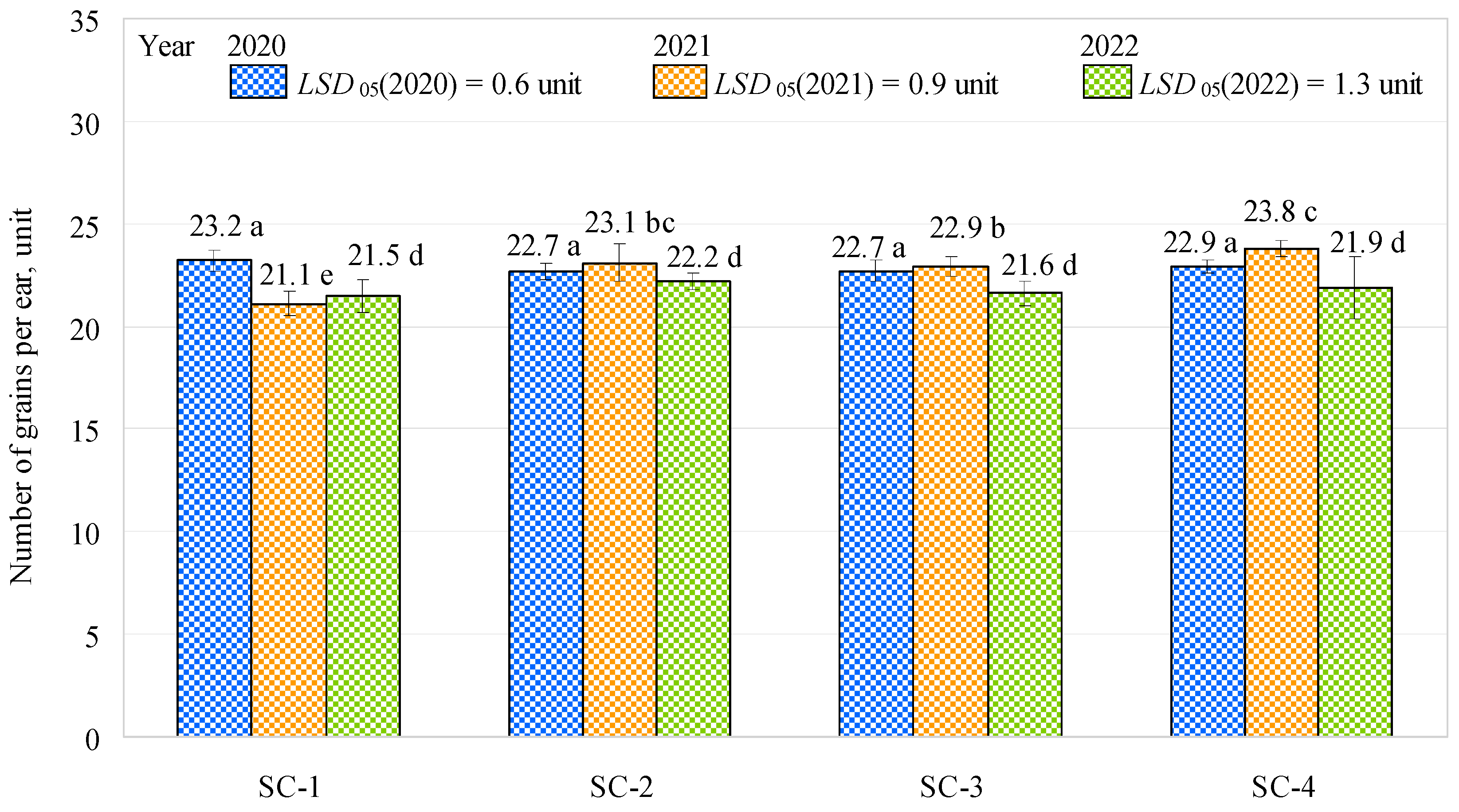
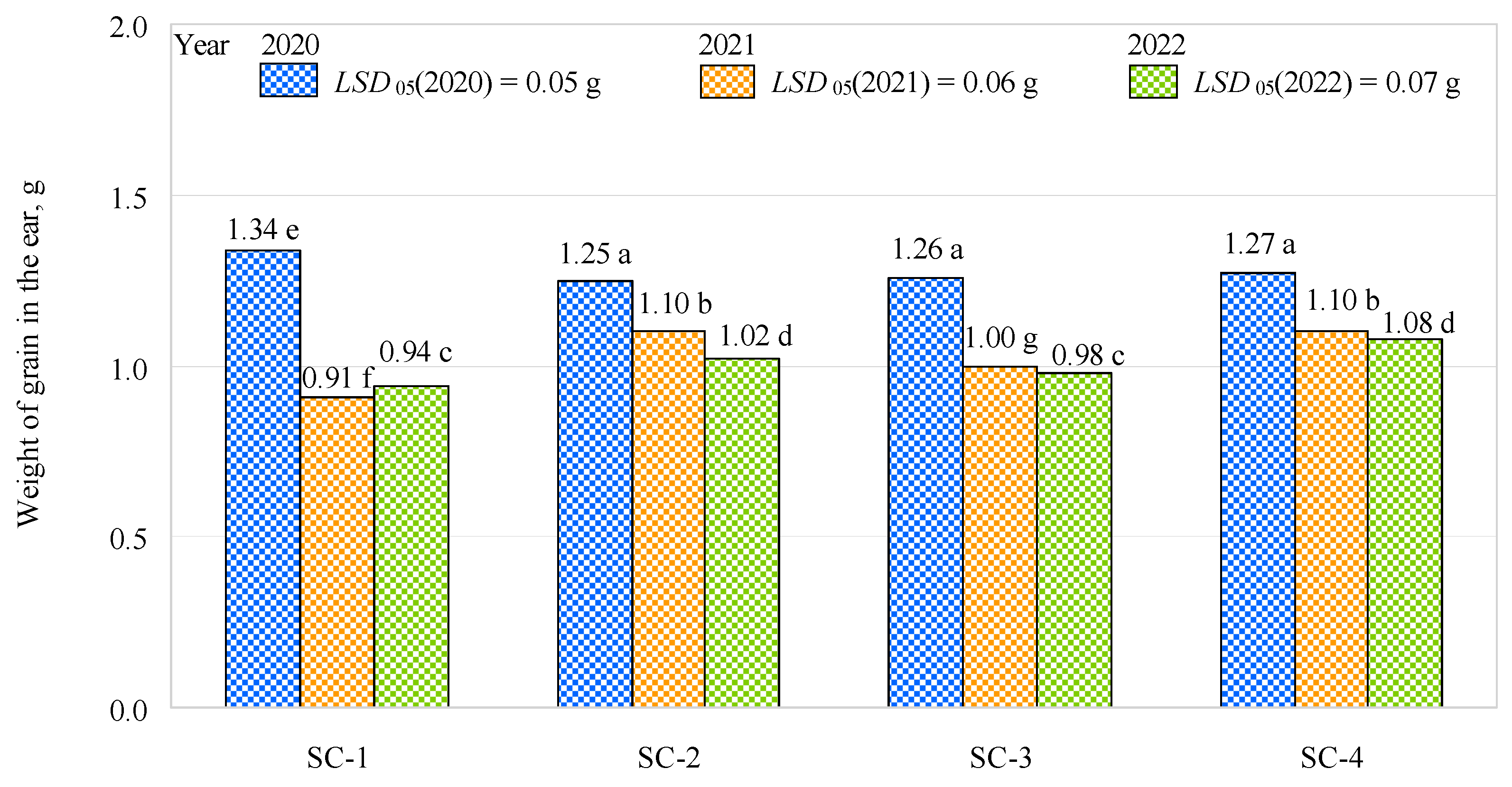
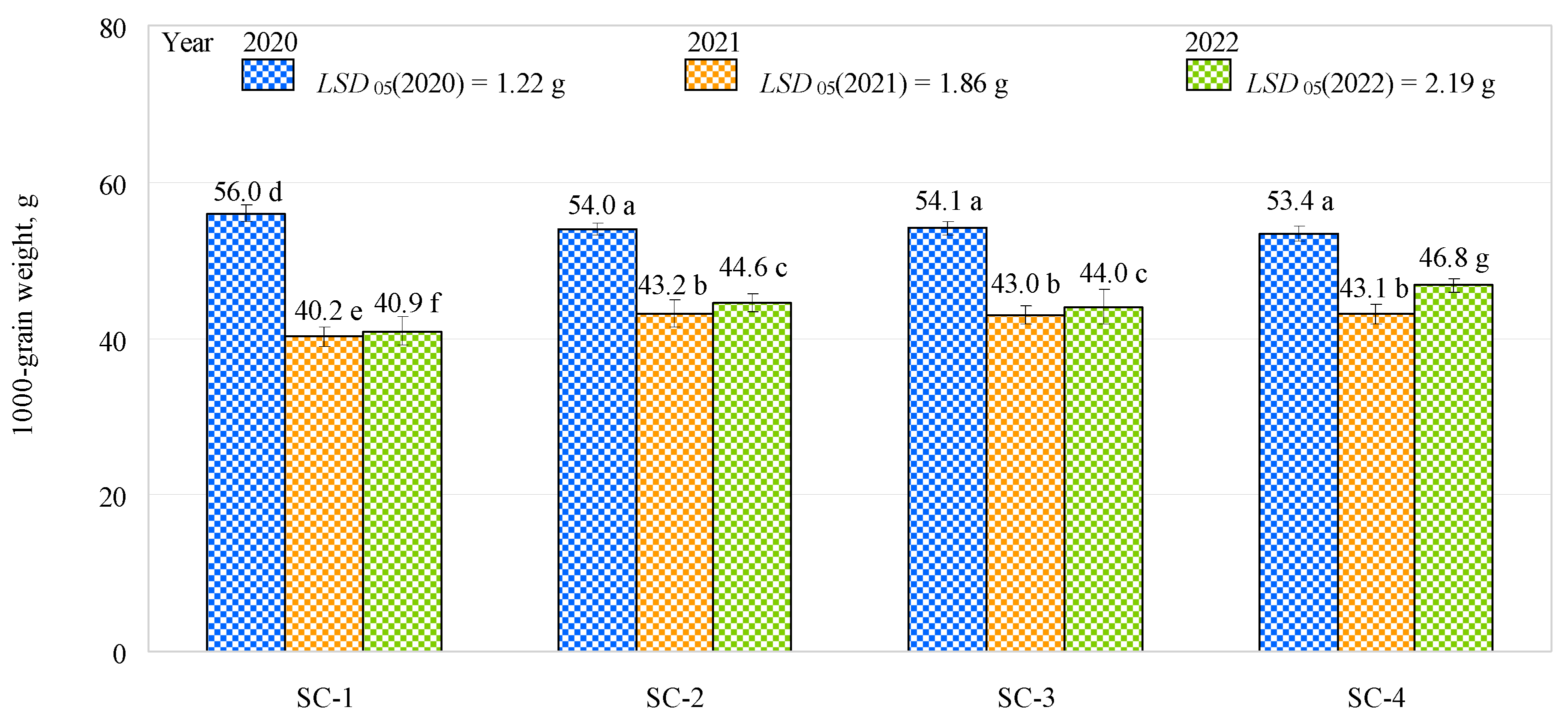

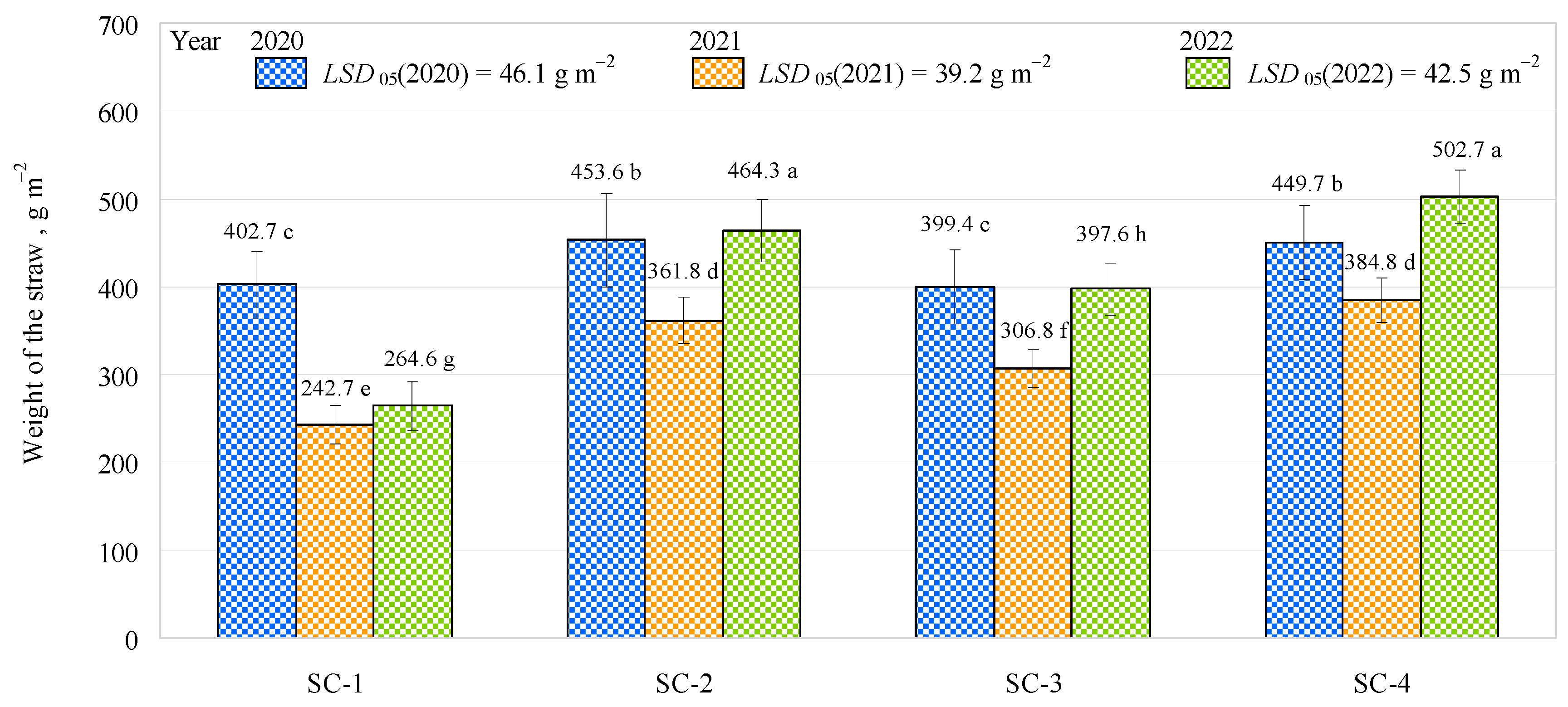
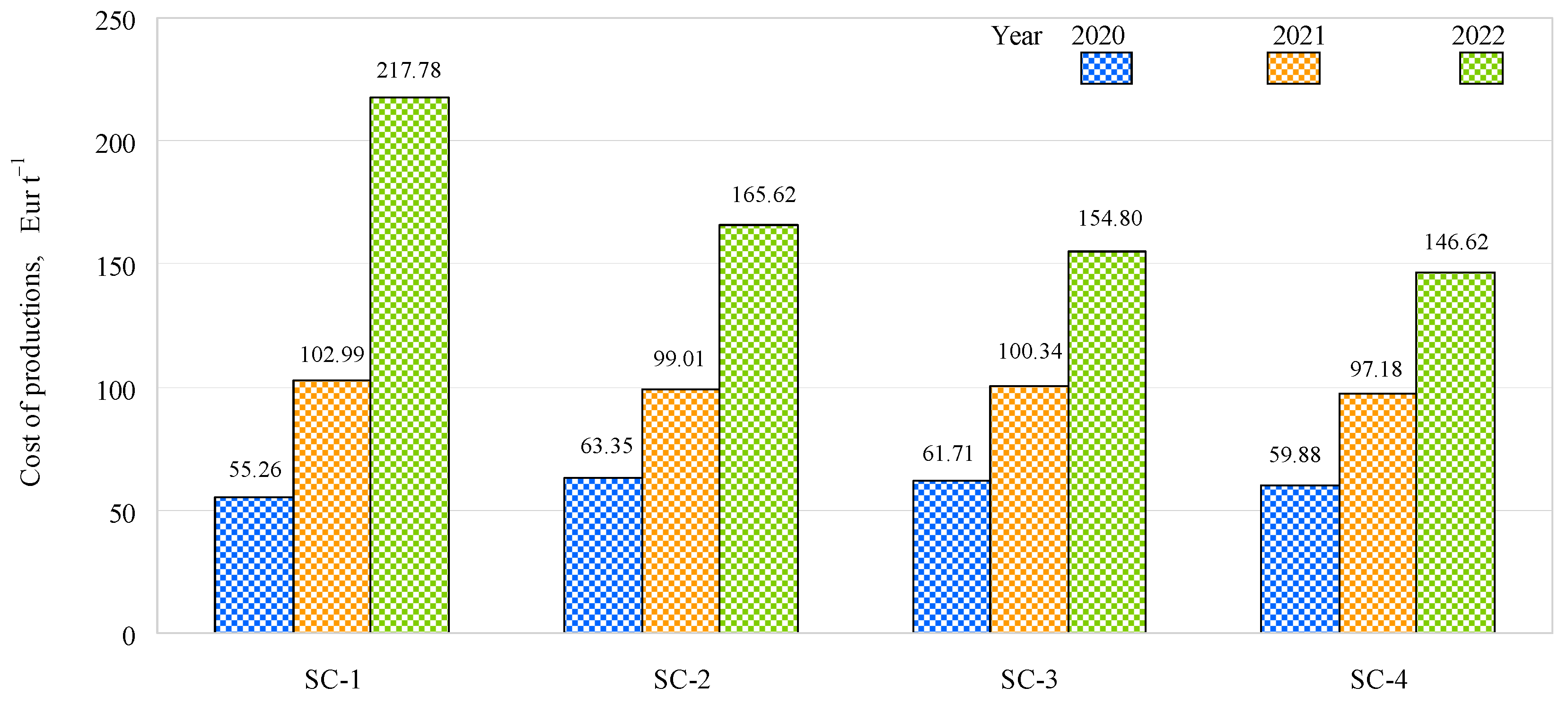
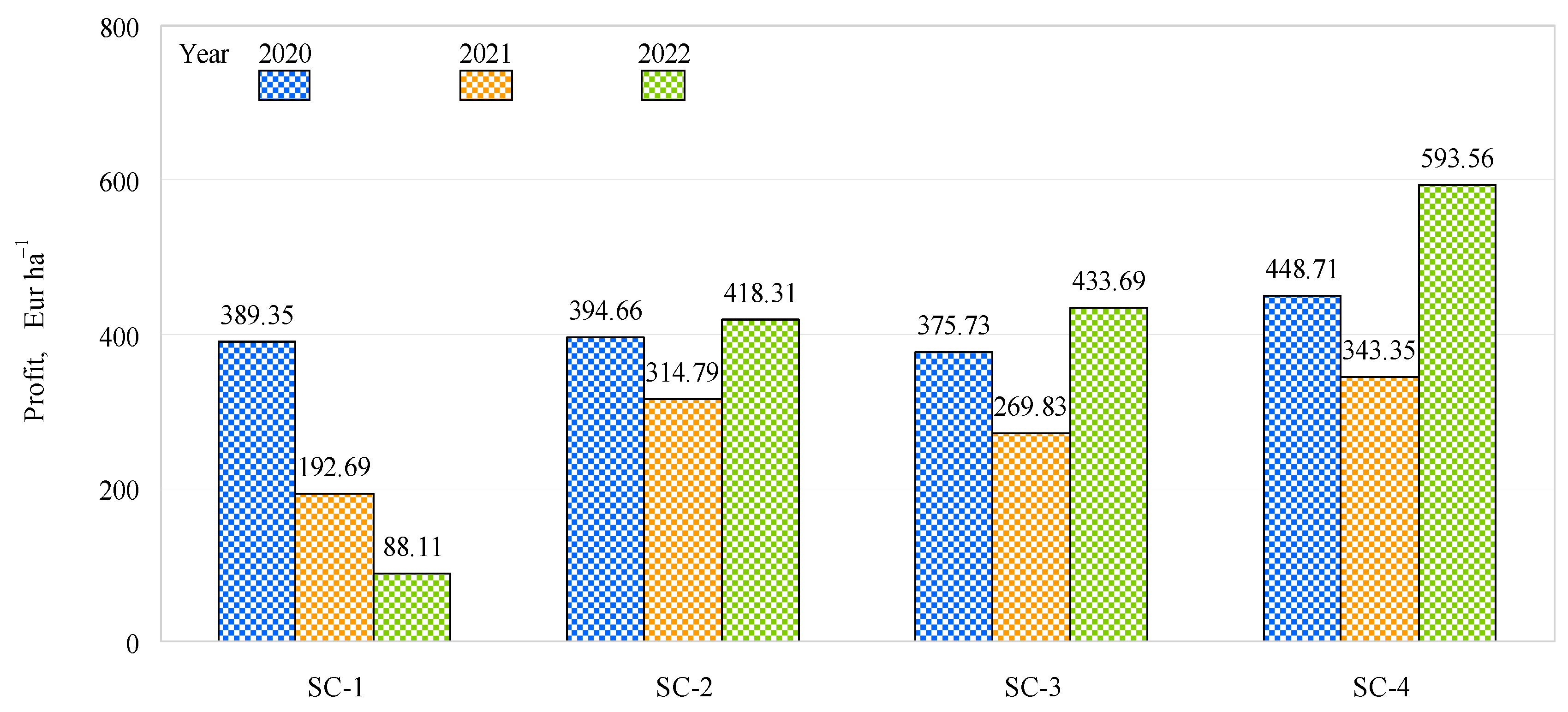
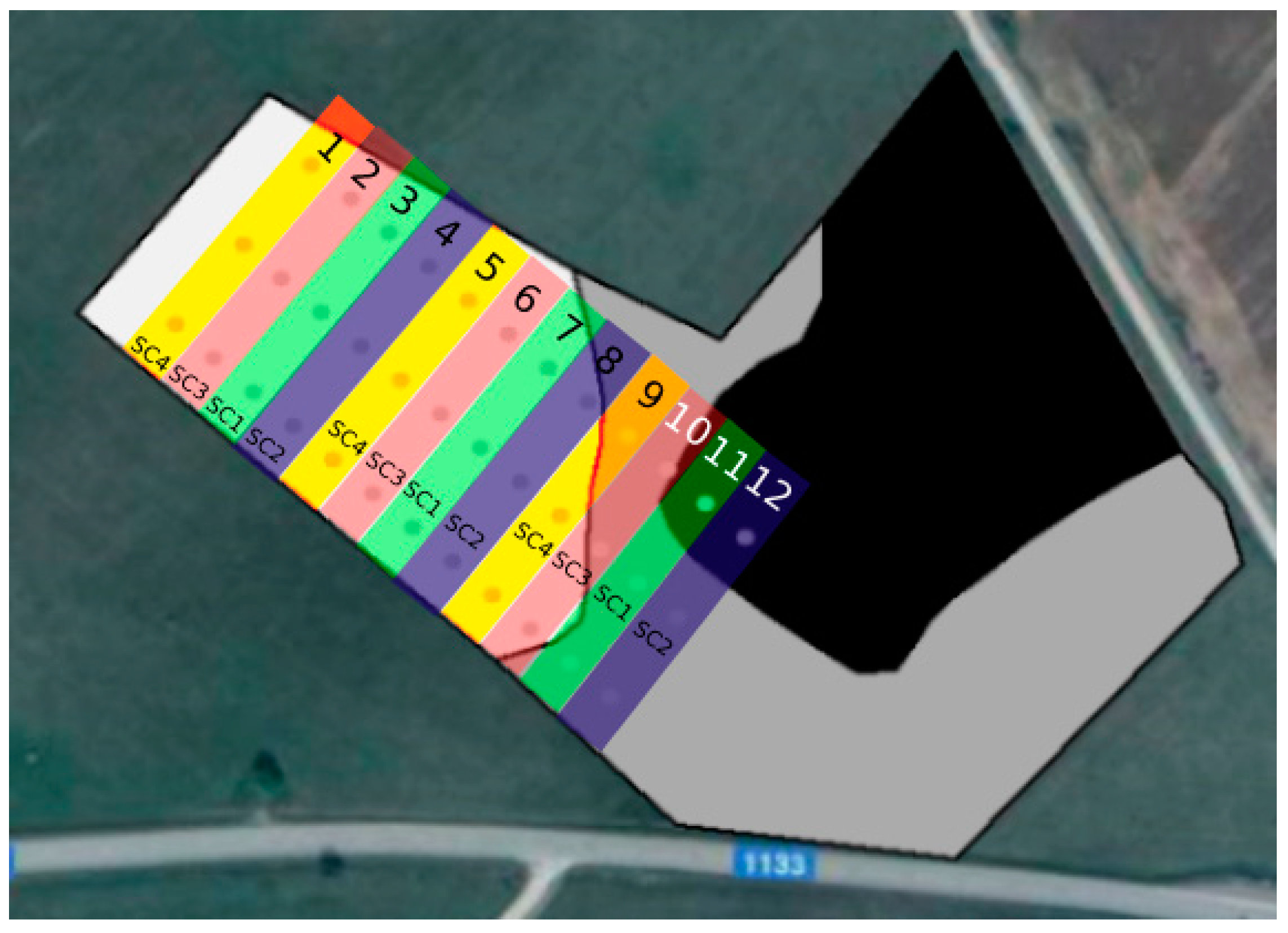
| Indicator | 2020 | 2021 | 2022 | |||||||||
|---|---|---|---|---|---|---|---|---|---|---|---|---|
| SC-1 | SC-2 | SC-3 | SC-4 | SC-1 | SC-2 | SC-3 | SC-4 | SC-1 | SC-2 | SC-3 | SC-4 | |
| Number of barley ears, unit m−2 | 699.1 ± 41.3 a | 841.2 ± 70.6 bc | 768.5 ± 57.4 ab | 875.2 ± 64.2 c | 507.6 ± 35.2 a | 687.3 ± 47 b | 625.9 ± 43.7 c | 750.1 ± 48.3 d | 453.3 ± 21.5 a | 729.2 ± 22.2 b | 652.1 ± 21.6 c | 798.8 ± 21.9 d |
| t-test | LSD05 (2020) = 81.3 units m−2 | LSD05 (2021) = 60.1 units m−2 | LSD05 (2022) = 61.9 units m−2 | |||||||||
| Barley ear-to-grain ratio, unit g−1 | 1.35 ± 0 a | 1.43 ± 0.1 b | 1.4 ± 0.1 ab | 1.37 ± 0.1 ab | 2.27 ± 0.1 a | 2.08 ± 0.3 ab | 2.05 ± 0.1 b | 2 ± 0.1 b | 2.01 ± 0.2 c | 1.6 ± 0.1 ab | 1.7 ± 0.2 a | 1.5 ± 0 b |
| t-test | LSD05 (2020) = 0.069 units g−1 | LSD05 (2021) = 0.222 units g−1 | LSD05 (2022) = 0.183 units g−1 | |||||||||
| Fertilization Scenario | Dosage of Fertilizer | Total Amount of Macroelement | |||
|---|---|---|---|---|---|
| At Sowing Time | At BBCH 25–30 | Nitrogen Ntot, kg ha−1 | Phosphorus Ptot, kg ha−1 | Potassium Ktot, kg ha−1 | |
| SC-1 (control) | 0.0 | 200 kg ha−1 NH4NO3 N34.4 | 68.8 | 0.0 | 0.0 |
| SC-2 | 300 kg ha−1 N5P20.5K36 | 83.8 | 61.5 | 108.0 | |
| SC-3 | 150 kg ha−1 N5P20.5K36 + 0.5 kg ha−1 bacteria | 76.3 | 30.8 | 54.0 | |
| SC-4 | 300 kg ha−1 N5P20.5K36 + 0.5 kg ha−1 bacteria | 83.8 | 61.5 | 108.0 | |
| Period | pH | P2O5, mg kg−1 | ||||||
| SC-1 | SC-2 | SC-3 | SC-4 | SC-1 | SC-2 | SC-3 | SC-4 | |
| Spring 2020 | 5.5 ± 1.2 | 5.6 ± 1.8 | 5.3 ± 1.0 | 5.3 ± 1.3 | 88 ± 71 | 72 ± 60 | 68 ± 36 | 66 ± 25 |
| Autumn 2020 | 5.4 ± 1.2 | 5.4 ± 1.7 | 4.8 ± 0.8 | 4.9 ± 0.5 | 82 ± 50 | 90 ± 159 | 45 ± 26 | 57 ± 26 |
| Spring 2021 | 5.6 ± 1.8 | 5.6 ± 1.6 | 5.1 ± 1.0 | 5.0 ± 0.9 | 75 ± 64 | 54 ± 48 | 50 ± 26 | 53 ± 19 |
| Autumn 2021 | 5.2 ± 1.0 | 5.4 ± 1.7 | 4.9 ± 0.6 | 4.8 ± 0.8 | 99 ± 68 | 60 ± 17 | 75 ± 33 | 75 ± 22 |
| Spring 2022 | 5.2 ± 1.6 | 5.5 ± 2.1 | 4.8 ± 0.9 | 4.8 ± 0.7 | 83 ± 57 | 79 ± 60 | 56 ± 30 | 74 ± 23 |
| Autumn 2022 | 5.2 ± 1.6 | 5.5 ± 2.3 | 5.4 ± 1.1 | 4.7 ± 0.2 | 79 ± 54 | 76 ± 53 | 60 ± 26 | 65 ± 10 |
| K2O, mg kg−1 | Humus, % | |||||||
| SC-1 | SC-2 | SC-3 | SC-4 | SC-1 | SC-2 | SC-3 | SC-4 | |
| Spring 2020 | 96 ± 37 | 87 ± 13 | 77 ± 11 | 84 ± 23 | 1.74 ± 0.22 | 1.58 ± 0.67 | 1.78 ± 0.38 | 1.50 ± 0.31 |
| Autumn 2020 | 76 ± 21 | 72 ± 16 | 70 ± 16 | 87 ± 11 | 1.80 ± 0.40 | 1.95 ± 0.15 | 1.84 ± 0.63 | 1.70 ± 0.24 |
| Spring 2021 | 95 ± 27 | 81 ± 17 | 78 ± 7 | 92 ± 17 | 2.14 ± 0.58 | 2.00 ± 0.23 | 2.04 ± 0.35 | 2.21 ± 0.21 |
| Autumn 2021 | 102 ± 15 | 80 ± 22 | 89 ± 15 | 108 ± 11 | 2.05 ± 0.31 | 1.83 ± 0.44 | 1.92 ± 0.61 | 1.87 ± 0.28 |
| Spring 2022 | 99 ± 29 | 86 ± 20 | 82 ± 18 | 102 ± 8 | 1.68 ± 0.35 | 1.51 ± 0.27 | 1.52 ± 0.25 | 1.60 ± 0.33 |
| Autumn 2022 | 89 ± 43 | 79 ± 13 | 71 ± 10 | 101 ± 10 | 1.57 ± 0.33 | 1.69 ± 0.36 | 2.11 ± 1.06 | 1.85 ± 0.54 |
Disclaimer/Publisher’s Note: The statements, opinions and data contained in all publications are solely those of the individual author(s) and contributor(s) and not of MDPI and/or the editor(s). MDPI and/or the editor(s) disclaim responsibility for any injury to people or property resulting from any ideas, methods, instructions or products referred to in the content. |
© 2023 by the authors. Licensee MDPI, Basel, Switzerland. This article is an open access article distributed under the terms and conditions of the Creative Commons Attribution (CC BY) license (https://creativecommons.org/licenses/by/4.0/).
Share and Cite
Anušauskas, J.; Steponavičius, D.; Romaneckas, K.; Lekavičienė, K.; Zaleckas, E.; Sendžikienė, E. The Influence of Bacteria-Inoculated Mineral Fertilizer on the Productivity and Profitability of Spring Barley Cultivation. Plants 2023, 12, 1227. https://doi.org/10.3390/plants12061227
Anušauskas J, Steponavičius D, Romaneckas K, Lekavičienė K, Zaleckas E, Sendžikienė E. The Influence of Bacteria-Inoculated Mineral Fertilizer on the Productivity and Profitability of Spring Barley Cultivation. Plants. 2023; 12(6):1227. https://doi.org/10.3390/plants12061227
Chicago/Turabian StyleAnušauskas, Justinas, Dainius Steponavičius, Kęstutis Romaneckas, Kristina Lekavičienė, Ernestas Zaleckas, and Eglė Sendžikienė. 2023. "The Influence of Bacteria-Inoculated Mineral Fertilizer on the Productivity and Profitability of Spring Barley Cultivation" Plants 12, no. 6: 1227. https://doi.org/10.3390/plants12061227
APA StyleAnušauskas, J., Steponavičius, D., Romaneckas, K., Lekavičienė, K., Zaleckas, E., & Sendžikienė, E. (2023). The Influence of Bacteria-Inoculated Mineral Fertilizer on the Productivity and Profitability of Spring Barley Cultivation. Plants, 12(6), 1227. https://doi.org/10.3390/plants12061227











